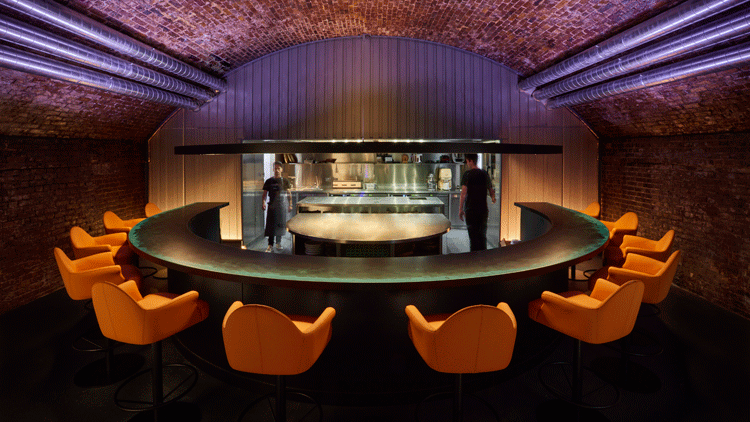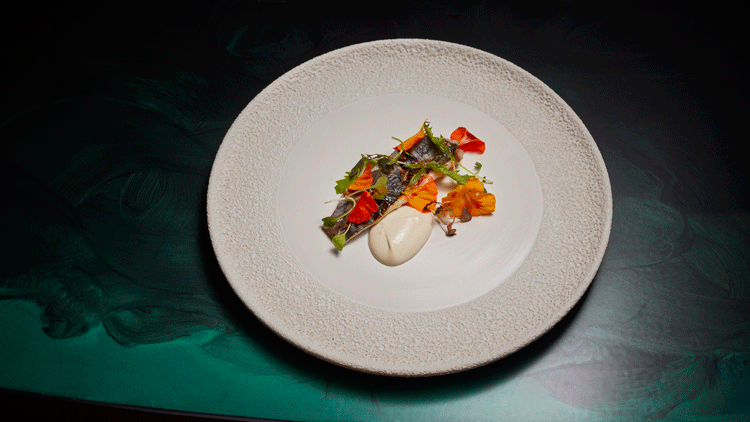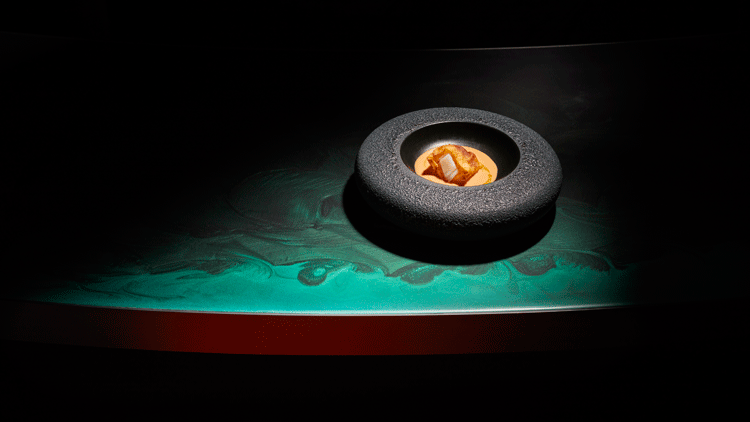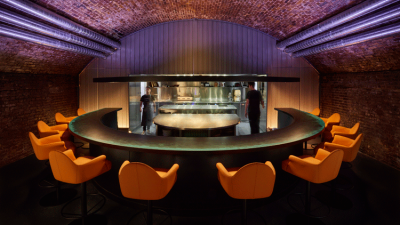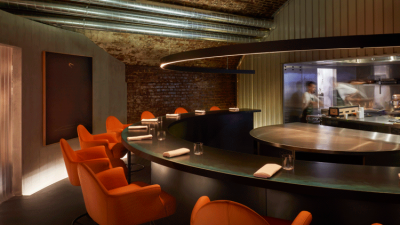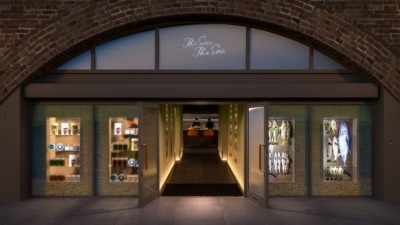Counter intuitive: the new seafood bar concept that specialises in aged fish

The most notable thing about The Sea, The Sea’s fish prep kitchen is the smell, or rather the lack of it. We’re surrounded by several large boxes of fish – grey mullet, sea bass, monkfish and several others that aren’t as easily identifiable – yet the only detectable odour is a faint impression of the sea.
Located under a railway arch in Hackney’s Haggerston area, Alex Hunter and chef Leo Carreira’s follow-up to their Chelsea ‘fish shop’ and high-end seafood bar marks the brand’s wholesale debut, with the new site acting as a processing space, distribution hub and showroom for chef customers as well as housing a 12-seater counter restaurant.
Tomorrow’s orders are casually scrawled on a whiteboard on the wall. Though Hunter would rather we didn’t reveal who his customers are – he is now looking for a more discrete way of keeping track of which kitchen is buying what – but suffice to say it’s a veritable who’s who of London’s produce-led restaurants.
The Hackney location and move into supplying other chefs has been part of the plan since the pair launched their original The Sea, The Sea site on Pavilion Road just north of Sloane Square in 2019.
"Our primary concern is to buy the best fish at the best price for ourselves,” says Hunter, a former aircraft sales consultant who, prior to The Sea, The Sea, ran sustainably-minded seafood group Bonnie Gull. “Supplying fish to other restaurants gives us more buying power and allows us to source directly from boats as well as fish markets.”
The pair are sourcing from all over the UK but with a focus on the South West, where they have a driver that makes regular runs from ports including Looe, Newlyn, Plymouth and St Ives to London.
“This gives us complete control over the product and cuts down on time lag,” continues Hunter. “We can get fish that was caught last night here the following afternoon and send it out to other restaurants that evening.”
Getting better with age
But while for many species speed remains the name of the game, a big part of The Sea, The Sea’s appeal for chefs is Carreira’s fish aging expertise. The restaurant’s frontage gives passers by a full view of the venue’s walk-in aging fridge, which like fridges designed for meat aging utilises blocks of Himalayan salt to reduce moisture levels.
While aging fish is not a new idea in culinary circles, it does go against the received wisdom that spanking fresh is best when it comes to things that come out of the sea. “Some species work better than others,” says the Portuguese-born Carreira, who possesses a top-flight cooking CV that includes a stint at Spain’s influential Murgaritz and senior roles at London restaurants including Lyle's, Koya and Nuno Mendes’ erstwhile flagship Viajante.
He has spent the past few years carefully documenting which species work best and how the aging process changes them. “Fat content is a factor. In general fish with a high oil content cannot be aged for extended periods. It’s typically large fish such as turbot, seabass and monkfish that work the best.”
The difference can be huge. Monkfish is a great fish but can often be wet and pappy. Dry aging firms the fish up and concentrates the taste. “It totally transforms the flavour. You get immense amounts of umami. It’s remarkable,” continues Carreira, who has experimented with extreme aging regimes that result in fish that have a texture that’s akin to ham and therefore can only be served raw or very lightly cooked so as not to dry them out.
The Sea, The Sea does not charge restaurants for looking after the fish, just the original weight of the catch (with each fish losing up to 100g of weight a day as it ages, the business would make a significant loss if it were to charge for the final weight of the product).
Raising the bar: The Sea, The Sea evolves
The cooking style at the original The Sea, The Sea is to some extent dictated by the restrictions of the space. The Chelsea site has A1 (retail) planning consent, which precludes heavy duty cooking. The kitchen, if you can even call it that, is tiny with only a few pieces of cooking kit, including a single induction hob, blowtorch, and dehydrator.
“My food is not finnicky, given what we’re working with it can’t be. It’s also 100% produce-led,” says Carreira. “We try not to call it a restaurant,” interjects Hunter. “It’s a seafood bar. We do small plates of protein that are very clean and minimal, but a lot of work goes into it behind the scenes.”
The kitchen at the Hackney site is much larger and is fully kitted out. But access to new toys won’t result in a major change of direction for The Sea, The Sea. “It’s going to be recognisable to what we do in Chelsea,” says Hunter. “An evolution is probably the best way to describe it.”
Carreira’s cooking style largely defies categorisation. There are a few nods to Portugal in the desserts and many of his techniques and flavours are inspired by Japan. Yet it’s highly distinctive, stripped-back fare that’s certainly on the more hardcore foodie end of the restaurant spectrum.
Having one’s cake and eating it
The 12-course, £110 tasting menu begins with a selection of snacks all based on raw or nearly raw seafood, including a crisp topped with cockles designed to taste of nothing but the sea and a little parcel of white crab meat wrapped in corn that’s inspired by inari sushi pockets.
These are followed by the likes of razor claims covered in black garlic gel; squid with New Zealand spinach; and caviar and kohlrabi served in a toasted rice broth.
But it’s the final two savoury courses that leave the most lasting impression. A small piece of 10-day-aged turbot with a sauce made from its bones, four types of vinegar and olive oil is nothing short of a revelation. Still perfectly moist but packing an incredible umami rich flavour, it is an impressive showcase for the benefits of aging fish.
Carreira’s langoustine wedding cake dish shows a more playful and daring side. Made with just egg, seaweed and togarashi and cooked in a special Portuguese metal pot, it is filled with grilled langoustine bound with a sauce made from the crustacean’s heads, iced with homemade almond cream and finished with langoustine floss.
A whole other kettle of fish
Modern and stripped back, the new space chimes with Carreira’s cooking style. “Just like Chelsea, we don’t have guys in wellies or water all over the floor. It’s more restaurant than fishmongers in terms of design and the overall experience. When we first opened in Chelsea people were a little confused by that,” says Hunter.
In fact, when the pandemic hit many Chelsea residents assumed the business had pivoted to retail. Before lockdown the split between restaurant revenue and retail revenue was 65% in favour of the former, now it’s closer to 50:50.
Chelsea has a little more of a neighbourhood vibe and far more passing trade than the new Hackney site, offering a simpler (yet still ambitious) a la carte menu for those who might wander by alongside its counter tasting menu.
“Everybody pigeonholes Chelsea as rich and Hackney as not rich, but if you look at the house prices round here, I don't think that's the case,” says Hunter. “The big difference between the two sites is that Hackney will be bookings-only and we won’t sell directly to the public, although we will use it fulfil deliveries.”
Being as sustainable as possible
Bonnie Gull – which at one point operated three London restaurants but closed its sole remaining restaurant during the pandemic - was a champion of British wild-caught fish to the extent that it refused to serve salmon or tuna. The Sea, The Sea is also a strong advocate of seafood from British waters, but it does serve some products from further afield including prawns from the Mediterranean and caviar.
“We’re 80% to 90% British,” says Hunter. “But you can’t open a fishmongers in Chelsea and expect to survive without selling salmon or tuna. We’re very careful when sourcing, for example our salmon comes from a sustainably-run farm in Norway. But we try and expand the repertoire of our more adventurous retail customers by putting them onto quality British-caught fish, especially the less obvious ones.”
Like an increasing number of chefs and restaurateurs that work with relatively small volumes of high-quality seafood, the pair value sustainability insights from the fishermen they work with above information produced by NGOs.
Hunter describes sustainability as a grey area. “Organisations such as the MSC (Marine Stewardship Council) produces lists of which species should not be caught because they’re in decline. But when you speak to the people who go out on the boats they say some of these species are so abundant they can’t help catching them.”
“We speak to fishermen and market buyers via WhatsApp at horrible-o-clock in the morning to find out what’s plentiful and therefore cost effective. Yes, there are certain things that we do avoid. But it’s a topic that’s incredibly sensitive and difficult. We just try not to make any obvious blunders.”
Again like Bonnie Gull, The Sea, The Sea is big on lesser known species, with Carreira currently working with ling, garfish and horse mackerel. Also known somewhat less romantically as common scad, the latter is a good example of a species that’s highly prized in other countries but pretty much ignored on these shores.
“Grey mullet is another underrated fish we really like. With a bit of aging, it’s as good as sea bass but it costs a fraction of the price,” says Carreira.
Judging by The Sea, The Sea’s order board, the pair's counter intuitive approach to fish handling appears poised to make its mark on top-end restaurant menus. We might soon be asking not how fresh the fish is, but how long it has been aged for.
